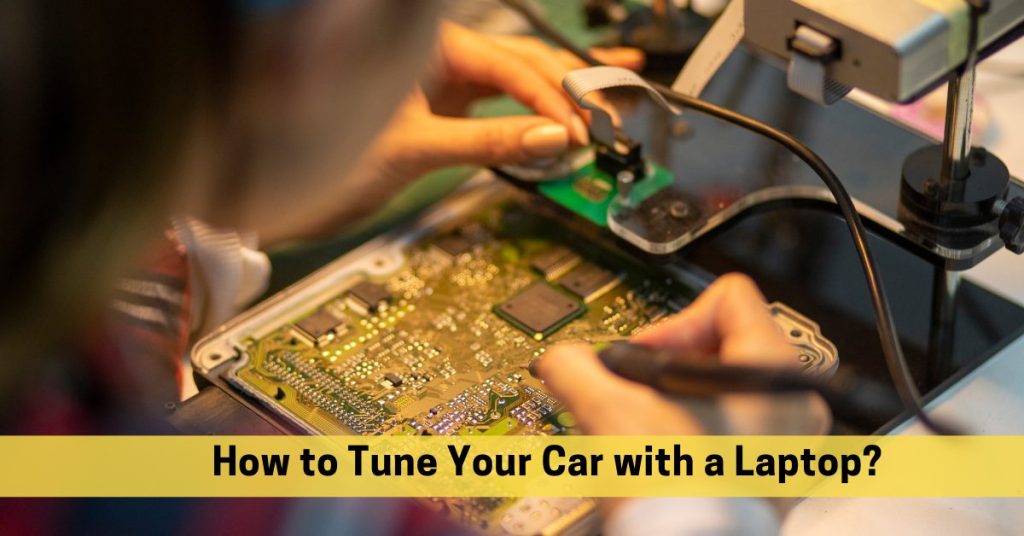To improve engine performance, fuel efficiency, and overall driving experience, car tuning with a laptop is necessary. A modern car is more than just a simple mechanical device. The use of electronic control units (ECUs) and sensors has made it possible to tune your car’s performance with just a laptop.

Additionally, tuning a car with a laptop allows you to tune ignition timing, air-fuel ratios, and transmission settings for optimal performance.
A laptop can improve the horsepower, torque, fuel efficiency, and overall performance of your car. This article provides a step-by-step guide on how to tune a car with a laptop.
Tune your car’s performance with a laptop using specialized software to modify engine parameters and improve driving experience.
Table of Contents
Materials Needed To Perform Car Tuning
Before tuning your car, it’s essential to have all the necessary materials and equipment to ensure a successful and safe process.
- Laptop
- Tuning Software
- OBD-II Cable or Wireless OBD-II Adapter
- Professional mechanic Assistant
How to Tune a Car with a Laptop: A Detailed Guide
What Exactly Is Car Tuning?
Before we dig into the details of tuning a car with a laptop, we should understand the basics of car tuning. In order to tune a car, certain parameters must be adjusted, including fuel delivery, ignition timing, and air intake. You can adjust these parameters manually or with the help of specialized tuning software.
Step 1: Install Tuning Software
Using a laptop for tuning your car requires installing specialized tuning software. Many tuning software options are available on the market, including EcuTek, Cobb, and HP Tuners. You should choose software compatible with your car’s make and model.
Step 2: Connect the Laptop to Your Car
Next, you have to connect your laptop to the OBD-II port of your car. OBD-II ports are standard diagnostic ports that communicate with your car’s ECU. You will usually find it under the dashboard or near the center console.
To connect your laptop to the OBD-II port, you will need an OBD-II cable or a wireless OBD-II adapter. Once you have connected your laptop to the OBD-II port, open the tuning software on your laptop.
Step 3: Read the Car’s Current Settings
It’s important to read and understand the current settings of your car before making any changes. The tuning software will allow you to read the car’s current settings, such as fuel delivery, ignition timing, and air intake.
In addition, you can view data from a variety of sensors, including an oxygen sensor, a throttle position sensor, and a mass airflow sensor.
Step 4: Make Changes to the Car’s Settings
By understanding your car’s current settings, you can make changes to its parameters. Performance can be improved by adjusting fuel delivery, ignition timing, air intake, and other parameters with tuning software. It’s important to make small changes and test the car after each change to ensure that the performance is improving.
Step 5: Test the Car
Once you’ve adjusted your car’s settings, test it to make sure the performance has improved. Take your car for a test drive and monitor its performance using the tuning software. Once the performance of your car has improved, you can fine-tune it further.
Step 6: Save Your Settings
After achieving the desired performance, it is crucial to save your settings. You can save your new settings as a custom map using the tuning software. Your factory map can be switched with your custom map at any time.
Benefits of Tuning Your Car with a Laptop
Tuning your car with a laptop can offer several following benefits.
- Improved Performance: Tuning your car with a laptop can improve its horsepower, torque, fuel efficiency, and overall performance.
- Customizable Settings: By tuning your car on your laptop, you can adjust its settings to your preference.
- Cost-Effective: Laptop tuning is a cost-effective alternative to other performance upgrades for your car.
- Easy to Install: It is easy to install tuning software and connect your laptop to your car’s OBD-II port.
Risks of Tuning Your Car with a Laptop
Tuning your car with a laptop does come with some following risks.
- Warranty Void: If you tune your car with a laptop, you are changing the parameters of the car’s engine, which may invalidate the warranty.
- Potential Damage: If your car’s engine is damaged, it can be costly to repair if the tuning process isn’t done correctly.
- Legal Issues: You may face legal issues if you modify your car’s engine parameters in some states or countries.
- Need for Expertise: Laptop tuning requires expertise in engine mechanics as well as knowledge of electronic controls. In case you don’t have the necessary knowledge, it is best to seek professional assistance.
Conclusion
Tuning your car with a laptop can be a cost-effective method of improving its performance. You can customize your car’s settings according to your preferences, and it’s easy to install. However, tuning your car with a laptop comes with some risks, such as voiding your warranty and potentially damaging your engine. Make sure you have the necessary expertise and knowledge before tuning your car with a laptop, and follow the steps carefully.


